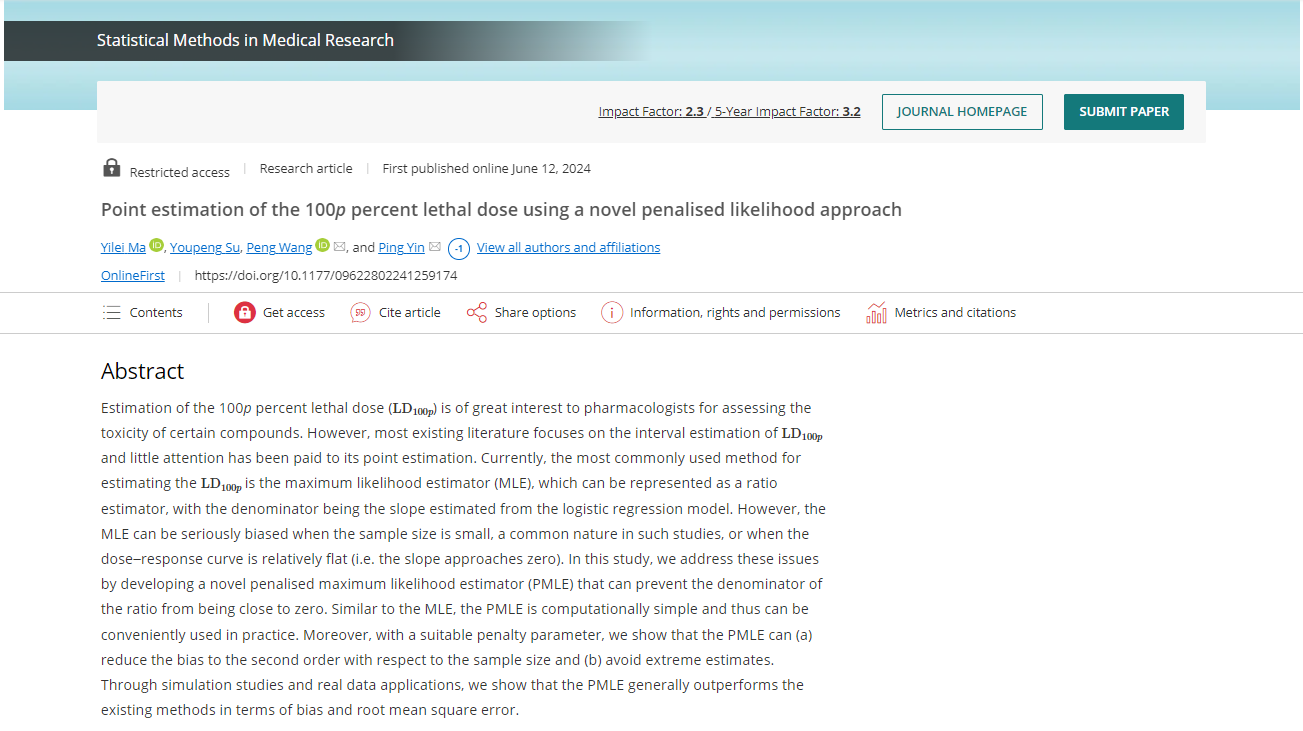On June 12, 2024, a first-class journal in biostatistics Statistical Methods in Medical Research published online the latest research results of the research group of Professor Ping Yin from Huazhong University of Science and Technology entitled “Point estimation of the 100p percent lethal dose using a novel penalised likelihood approach” (https://journals.sagepub.com/doi/10.1177/09622802241259174). This study proposed a novel penalised maximum likelihood estimator for the 100p percent lethal dose, which can reduce the bias to the second order with respect to the sample size and avoid extreme estimates.

The 100p percent lethal dose (LD100p), such as the median lethal dose (LD50) or 90% lethal dose (LD90), is frequently used in the biological assay experiments as a summary measure of the experimental data. Currently, the most commonly used method for estimating the LD100p is the maximum likelihood estimator (MLE), which can be represented as a ratio estimator, with the denominator being the slope estimated from the logistic regression model. However, the MLE can be seriously biased when the sample size is small, a common nature in such studies, or when the dose–response curve is relatively flat. Focusing on the above issues, the researchers conducted the study based on a novel penalised likelihood theory.
For experiments with small sample sizes or a flat dose–response curve, the data may not contain sufficient information and the shape of the likelihood function may also be relatively flat, thus extreme MLEs for LD100p may be produced in these scenarios. The researchers addressed these issues by developing a robust estimator using a novel penalised likelihood approach that can prevent the denominator of the ratio from being close to zero, avoiding the occurrence of extreme estimates. This study further found that when the penalty parameter is fixed to be 1, it can be theoretically proven that the bias of proposed estimator is smaller than that of the MLE, reducing from first-order to second-order with respect to the sample size. In addition, the proposed estimator in this study has a simple closed form, which is more convenient for researchers to apply.
Through theoretical derivation, numerical simulations as well as real data analysis, this study confirmed that the proposed estimator has a better performance than competing methods in terms of bias and root mean square error. The new proposed method provides a more robust and effective choice for point estimation for LD100p. This study recommended usage scenarios for the proposed method:
1. For experiments with small to moderate sample sizes or a flat dose–response curve, the proposed estimator is highly recommended because less biased estimates can be obtained, which will provide important information for follow-up studies.
2. For experiments with a sufficient sample size or a steeper dose–response curve, the proposed estimator can also be used to obtain a theoretically less biased estimate without increasing the root mean square error in general.
Statistical Methods in Medical Research is an authoritative journal in the field of biological and medical statistical methods, aimed at enabling professionals to understand the various new statistical methods currently available.
Dr. Yilei Ma, a graduate, and Youpeng Su, a doctoral student, are co-first authors, while Professor Yin Ping and Assistant Professor Wang Peng are co-corresponding authors. The research was supported by the National Natural Science Foundation of China and the Fundamental Research Funds for the School of Public Health, Tongji Medical College, Huazhong University of Science and Technology.

